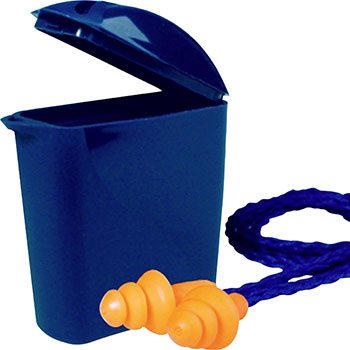Hearing Protection
Hearing protectors are required to prevent noise induced hearing loss. Hearing protection devices reduce the noise energy reaching and causing damage to the inner ear. Ear muffs and earplugs are the most common types of PPE.
- Recommendation
- Impact
- Types of Hearing Protection
- Hunting Hearing Protection
Michaelides & Vermaas recommends that workers wear hearing protectors when engaged in work that exposes them to noise that equals or exceeds 85 dBA.
Each year an estimated 22 million workers are exposed to noise loud enough to harm their hearing. The problem crosses many industries, including manufacturing, construction, agriculture, mining, and transportation.
Expandable foam plugs
These plugs are made of a formable material designed to expand and conform to the shape of each person’s ear canal. Roll the expandable plugs into a thin, crease-free cylinder. Whether you roll plugs with thumb and fingers or across your palm doesn’t matter. What’s critical is the final result—a smooth tube thin enough so that about half the length will fit easily into your ear canal. Some individuals, especially women with small ear canals, have difficulty rolling typical plugs small enough to make them fit. A few manufacturers now offer a small size expandable plug.
Pre-molded, reusable plugs
Pre-molded plugs are made from silicone, plastic or rubber and are manufactured as either “one-size-fits-most” or are available in several sizes. Many pre-molded plugs are available in sizes for small, medium or large ear canals.
A critical tip about pre-molded plugs is that a person may need a different size plug for each ear. The plugs should seal the ear canal without being uncomfortable. This takes trial and error of the various sizes. Directions for fitting each model of pre-molded plug may differ slightly depending on how many flanges they have and how the tip is shaped. Insert this type of plug by reaching over your head with one hand to pull up on your ear. Then use your other hand to insert the plug with a gentle rocking motion until you have sealed the ear canal.
Advantages of pre-molded plugs
They are relatively inexpensive, reusable, washable, convenient to carry, and come in a variety of sizes. Nearly everyone can find a plug that will be comfortable and effective. In dirty or dusty environments, you don’t need to handle or roll the tips.
Canal caps
Canal caps often resemble earplugs on a flexible plastic or metal band. The earplug tips of a canal cap may be a formable or pre-molded material. Some have headbands that can be worn over the head, behind the neck or under the chin. Newer models have jointed bands increasing the ability to properly seal the earplug.
The main advantage canal caps offer is convenience. When it’s quiet, employees can leave the band hanging around their necks. They can quickly insert the plug tips when hazardous noise starts again. Some people find the pressure from the bands uncomfortable. Not all canal caps have tips that adequately block all types of noise. Generally, the canal caps tips that resemble stand-alone earplugs seem to block the most noise.
Earmuffs
Earmuffs come in many models designed to fit most people. They work to block out noise by completely covering the outer ear. Muffs can be “low profile” with small ear cups or large to hold extra materials for use in extreme noise. Some muffs also include electronic components to help users communicate or to block impulsive noises.
Workers who have heavy beards or sideburns or who wear glasses may find it difficult to get good protection from earmuffs. The hair and the temples of the glasses break the seal that the earmuff cushions make around the ear. For these workers, earplugs are best. Other potential drawbacks of earmuffs are that some people feel they can be hot and heavy in some environments.
Any noise louder than 85 decibels can cause permanent hearing loss. I cannot state this strongly enough: if it is loud enough, a single gunshot can cause immediate hearing damage. For reference, a gunshot is about 130-180 decibels (give or take).
While noise induced hearing loss and tinnitus are both permanent, the good news is that it’s also preventable.
The Noise Reduction Rating (NRR) of ear protection describes how effective it is. Basically, a higher NRR means that hearing protection does a better job reducing your exposure to really loud noises.
However, you should keep in mind that some firearms produce a pressure wave strong enough cause hearing loss by damaging the bones behind the ear, even if the ear canal is protected by an ear plug. This is particularly true for people shooting indoors or those exposed to repeated shots from shotguns or rifles (such as waterfowl hunters or hunting guides). While ear plugs are certainly better than nothing, ear muffs are actually the most effective shooting and hunting ear protection you can wear.
So, to avoid permanent damage to your hearing, it is important that you wear appropriate ear protection when shooting or when exposed to other noisy environments. Luckily, this task is much easier than many people assume and there are a lot more good quality options for hearing protection while hunting than there used to be.




Not Sure What You Need?
Simply give us a call and book an appointment for yourself. We are here to help! Michaelides and Vermaas, your hearing care provider since 1992.
